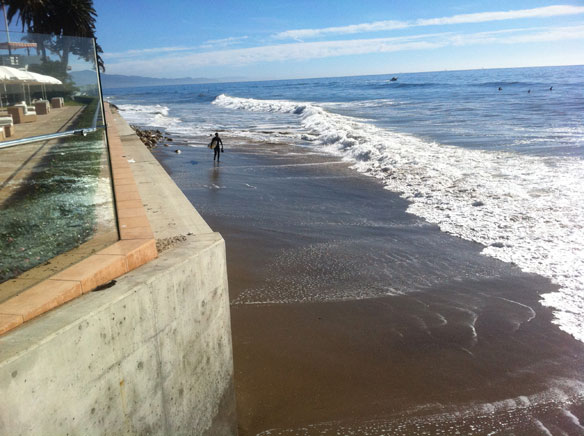Photograph: Seawall, Butterfly Beach, Santa Barbara, California © SAF — Coastal Care
For nearly a century, America’s coasts — particularly those with large urban populations — have been armored with human made structures such as seawalls.
These structures essentially draw a line in the sand that constrains the ability of the shoreline to respond to changes in sea level and other dynamic coastal processes. While the resulting ecological effects have been studied more in recent years, the research largely has been conducted in specific settings, making it difficult to generalize these effects across ecosystems and structure types.
A new study by a team of UC Santa Barbara marine scientists and colleagues from three coastal sites in the National Science Foundation’s Long-Term Ecological Research (LTER) network provides a key first step toward generalizing ecological responses to armoring across the wide diversity of coastal settings where these structures are used. The team’s findings appear online and will be published this fall in a special issue of the journal Estuaries and Coasts, “Impacts of Coastal Land Use and Shoreline Armoring on Estuarine Ecosystems…
Also of Interest:
Is the coast clear? Not in many beachfront areas; NSF (07-24-2017)
Marine scientists evaluate coastal armoring and its ecological effects…
California Coastal Armoring Report: Managing Coastal Armoring and Climate Change Adaptation in the 21st Century; By Molly Loughney Melius, Fellow, Stanford Law School Margaret R. Caldwell, Diretor, Environment and Natural Resources Law & Policy Program, Stanford Law School(05-24-2015)
In response to erosion and storm events, Californians have built seawalls, revetments, and other “coastal armoring” structures along significant portions of California’s coast. Coastal armoring now occupies more than 110 miles, or at least 10 percent, of the overall California coastline. This coastal armoring has diminished California’s beaches and habitat, irreversibly altered bluffs, caused increased erosion to neighboring properties, and marred the natural beauty of the coast…
“Seawalls Kill Beaches,” Open Letters by Warner Chabot And Rob Young; (10-03-2014)
Sandbagging at the Shore: North Carolina’s Coastal Sand Bags and Political Sandbaggers; By William Neal, Orrin Pilkey & Norma Longo;
The wonder of modern English is how social use of language expands and changes the meaning of words. Sand bag is a bag filled with sand used for temporary construction—quickly made, easily transported, and easily removed. Typically, sandbagging is the emplacement of sand bags to construct a temporary protective wall or barrier, such as a dike or dam to hold back flood waters , or protection on the battlefield. But the term ‘sandbagging’ has taken on an array of other meanings…
Let’s end war with ocean, Op-Ed by Orrin H. Pilkey
The immediate future most certainly holds more miles of sandbags, resulting in more narrowed and ugly beaches.But this trend can be halted and reversed. Now is the time to make peace with the ocean.The time is now to stop sandbagging, both physically with no more shore-hardening structures, and politically with no more exceptions to the intent of the rules, no more undermining existing legislation, and a return to enforcement…
Rethinking Living Shorelines, By Orrin H. Pilkey, Rob Young, Norma Longo, and Andy Coburn;Program for the Study of Developed Shorelines / Western Carolina University, March 1, 2012, Nicholas School of the Environment, Duke University
In response to the detrimental environmental impacts caused by traditional erosion control structures, environmental groups, state and federal resource management agencies, now advocate an approach known as “Living Shorelines”that embraces the use of natural habitat elements such as indigenous vegetation, to stabilize and protect eroding shorelines.
NOAA Study Finds Marshes, Reefs, Beaches Can Enhance Coastal Resilience; NOAA (04-29-2015)
The resilience of coastal communities to storms, flooding, erosion and other threats can be strengthened when they are protected by natural infrastructure such as marshes, reefs, and beaches, or with hybrid approaches, such as a “living shoreline”…









